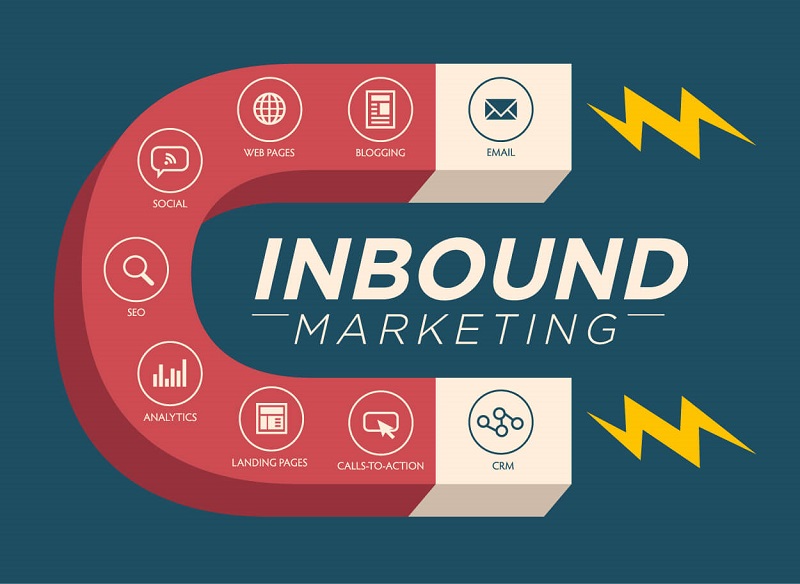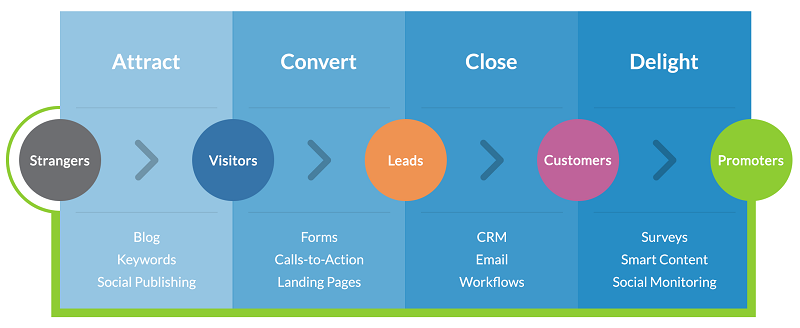Surely you’ve heard of the term Inbound or Inbound marketing methodology. But do you know what Inbound marketing is and what are its advantages?
We tell you all about this marketing methodology, its fundamental pillars, its stages or phases and its main benefits. With this technique, you can know your users much better and therefore improve your marketing strategy.
We start?
What is the Inbound marketing methodology?
The Inbound marketing methodology is a methodology that combines non-intrusive marketing and advertising techniques in order to attract potential customers.
The translation of Inbound according to Wikipedia is “technique to attract customers to your products and services through content marketing, social media marketing, search engine optimization and brand development”
The main difference between the Inbound in marketing and traditional marketing is that Inbound marketing is not focused on the sale, but is based on attracting the user on its own without the need for the user to find you.
User behavior has changed radically in recent years and they no longer want to be distracted by advertising, phone calls or other invasive techniques to offer products or services
Inbound Marketing Methodology VS Outbound Marketing
In the Inbound Marketing methodology, communication is interactive and bidirectional and non-intrusive communication techniques are used to offer valuable content.
In Outbound Marketing, communication is direct and unidirectional and employs techniques or marketing actions whose main objective is to attract consumers.
While Inbound Marketing focuses on marketing techniques “pull” (techniques that attract the user), Outbound Marketing focuses on techniques “push” (push technique)
What does the abbreviation of Inbound in Marketing mean?
➨ I: Interaction. You must interact with your customers through your marketing actions to build trust and interest in your brand.
➨ N: Novelty. This methodology is a new way of doing marketing and has great differences with traditional marketing.
➨ B: Branding. This method improves the brand image and helps generate branding.
➨ O: Organization. The organization is an essential aspect in your Marketing strategy.
➨ U: Unification. To achieve the proposed objectives we must create a strategy that is as homogeneous as possible.
➨ N: Naturalness. The techniques of this methodology should be based on naturalness to attract and retain customers, avoiding forced advertising and commercial techniques
➨ D: Dynamization. The Inbound in Marketing is based on the dynamization of the contents.
This methodology is not simply a marketing technique, but a more complex methodology formed by a series of techniques aimed at achieving a series of specific objectives. The methodology of attraction is based on 4 phases that correspond to the stages of a user’s purchase process:
1. Attract visitors
The inbound marketing methodology allows us to generate qualified traffic to our website. How to attract qualified traffic to a web page?
- Create valuable content
Create a blog and write about issues related to the products or services of your company will ensure you reach a quality audience.
- Work the SEO and the SEM of your web
Optimize your content through SEO positioning on page, SEO strategies off page and paid advertising to enhance and give more visibility to the work done with content marketing
- Work your strategy in social networks
Spread your content on the main social platforms to create a community of followers who visit and share the contents that are published.
2. Convert
Once you have managed to have qualified traffic for your website, the next thing is to try to get those customers to become leads or future buyers. For this, we need to obtain information about the different profiles of the buyer offering them something in return in the form of content whether they are ebooks, whitepapers, manuals, guides, podcast …
How do we convert visits into leads?
- With landings pages
Create a landing page or landing page with a simple form so that users can provide their data in exchange for an action: download an ebook, download a manual, access premium content … With this data, we have information of users to be able to Impact them and send them email marketing campaigns and personalized content.
- With CTAs
CTAs or calls to action are elements (buttons or links) that are included in web pages and encourage users to do something. They should draw the attention of the user with an attractive message that explains what they have to do and what they can achieve. For example, download ebooks, checklist or other content of value.
3. Close
The third stage of the methodology is to try to transform these leads into customers.
How to transform leads into customers?
- Email marketing strategy
We must segment the lists of our leads that we have achieved and send email marketing campaigns through a software to send mass emails with useful and personalized content depending on the stage of the purchase cycle in which they are.
4. Delight
In this last stage of Inbound marketing methodology, we have to convert our clients into happy promoters and evangelizers of our brand.
Remember that the process does not end when users buy our products and services, but we must turn them into happy consumers so that they continue to buy our products or services, speak well of us and promote us in their social networks or among their contacts and acquaintances.
How to build loyalty to our customers?
- Surveys
Create surveys to know the level of satisfaction of our users and guide your strategy based on the results obtained
- Offers and discounts
Offer your customers offers and discounts for your loyalty
How to develop an Inbound strategy in Marketing?
We already know what this value technique consists of and what the phases of this methodology are, but how do we implement an Inbound Marketing strategy?
1. Buyer person
The buyer person is the prototype of the ideal customer of a service or product. Makes a detailed description of your potential customers taking into account sociodemographic variables, tastes, ideas, behaviors, habits.
2. Understand the purchase cycle
The buying cycle is the process or path that passes a user since he discovers that he has a problem or need until you buy something that solves your need.
It is essential to understand the purchase cycle that our customers follow to create a successful attraction strategy, since according to the phase of the purchase cycle they are in, they will demand different things.
3. Create your offer
What will you offer your users?
Offer them something useful and relevant enough for the user to register. You can offer downloadable content such as ebook, guide, manual or a training course.
4. How will you offer this offer?
Define how your users will access your offers, which will normally be through a landing page or page specifically designed to convert visitors into leads.
5. Distribute your offer
How will your users access your offer? You will have to guide your potential customers through the conversion funnel to get quality traffic. Take advantage of all possible distribution channels in line with your Inbound Marketing strategy.
6. Analyze your results
Measure and analyze the results obtained with your attraction strategy and make decisions based on this. Detect the weak points and reorient your strategy if necessary.
Benefits of the Inbound marketing methodology
This methodology brings many advantages and benefits to businesses that are committed to it. What are these benefits?
- Visibility and brand awareness
Thanks to this marketing strategy, your brand can achieve great visibility and recognition with the production of content adapted to the purchase cycle. In addition, if you manage to build loyalty to your audience, they will share your content on their social networks and talk about you in their closest environment, thus improving your visibility.
- Win the client’s trust
With a non-invasive and attractive strategy for your users, you will gain their confidence quickly and they will see you as an expert in the sector.
- Engagement with the client
The content you generate for your Marketing strategy will allow you to interact with your clients and therefore generate engagement with your customers. In this way you can establish links or relationships between brand and consumer through valuable content.
- Get quality traffic and leads
Thanks to your quality content, you will get more visits and more traffic to your website, in addition, the chances of obtaining quality leads increase significantly.
- Cost savings
The strategies and techniques of Inbound cost much less than traditional marketing, as well as being more effective, because you offer what your audience is looking for. You get people to see you and easily find you by organic positioning, without having to pay for advertising in Google AdWords or social ads campaigns.
- ROI lighter
The methodology inbound marketing is measurable, since, being a totally digital process, we can analyze the metrics and the results obtained and therefore see if your strategy has been effective.
In short, Inbound Marketing is a novel technique with effective results and great advantages. I hope you have read this article. If you have any questions do not hesitate to leave me a comment.
And you? Still have not implemented the Inbound marketing methodology in your business?


